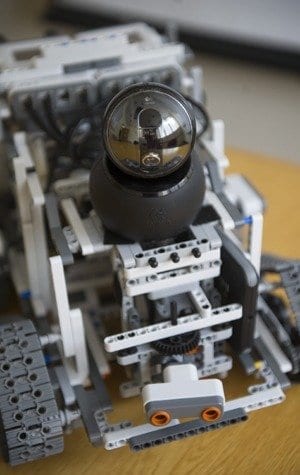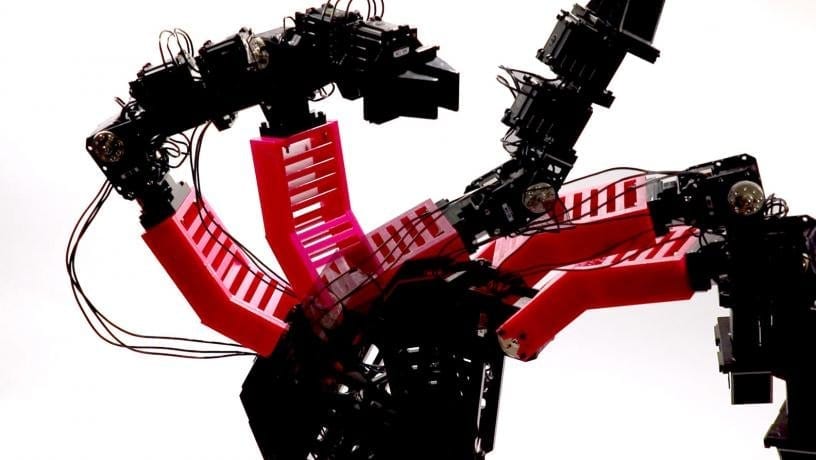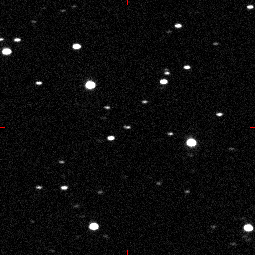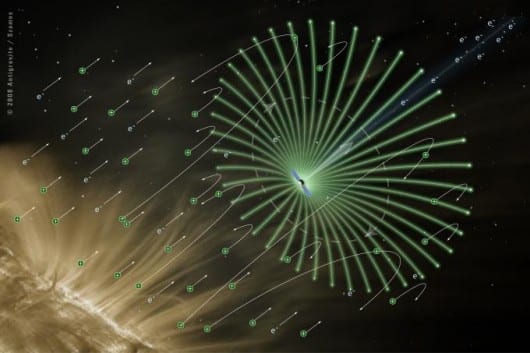
In The Jetsons, the helper robot of the future handles all manner of chores. Rosie can do the laundry, pick up the groceries, and keep Elroy out of trouble.
In today’s reality, we have all kinds of artificial intelligences (AIs) at work for us—scouring the web for information, diagnosing car trouble, even performing surgeries. But no one of these specialized machines could perform all those tasks, or any variety of tasks. In fact, even one of our everyday errands would pose a challenge for a traditional robot. Rosie would be stymied by a stray shopping cart in her path, and she wouldn’t know what to do if Jane’s favorite brand of margarine were out of stock.
But Massimiliano “Max” Versace, a College of Arts & Sciences research assistant professor and director of BU’s Neuromorphics Laboratory, aims to fix that. His team is building the brain of a versatile, general-purpose robot—maybe not a humanoid, wisecracking helper, but, let’s say, a really smart dog. And with a grant from NASA, that pup may soon be prowling other planets.
Versace (GRS’07) is working on the cutting edge of a convergence of neuroscience, computer processing, and other disciplines that promises to yield a better robot, one with a “brain” modeled after that of a mammal. He believes conventional robots are hamstrung by their basic architecture, which has changed little since the 1960s. By necessity, even a powerful supercomputer’s processing unit is located apart from its memory stores. The tiny delay as data travels between them is not noticeable because a typical AI today is devoted only to a single task or a narrow set of tasks.
But those delays would quickly multiply if a robot were asked to step outside that narrow field—adding car parts on an assembly line or answering questions on Jeopardy!—and into an unpredictable situation, such as exploring the ocean floor or caring for an elderly person. To prepare a robot for every possibility in that broader role, its programmers would have to add so many lines of code that the machine would need as much power as used by the entire Charles River Campus.
The brain of an ordinary rat, on the other hand, runs on the energy equivalent of a Christmas-tree bulb, Versace and colleague Ben Chandler (GRS’14) write in an article in IEEE Spectrum, a publication of the Institute of Electrical and Electronics Engineers, yet the rodent can successfully explore unfamiliar tunnels, avoid mousetraps, follow a food aroma coming from an unexpected source—all things that might befuddle a robot.
It’s that ability to learn and adapt that Versace is working to replicate in an artificial brain. To do it, he’s made use of a breakthrough electrical component designed by Hewlett-Packard, called a memristor. Versace and his team have assembled networks of these microscopic devices to mimic the brain’s neurons and synapses, saving a massive amount of energy while allowing the storage and processing of information to occur simultaneously, as they do in our mammalian heads.
In the lab’s first series of experiments, in 2011, the BU team built a rodent-size brain and let it loose in a virtual tub of water. With training, rather than explicit programming, the “animat” eventually figured out on its own how to find dry ground.
Robo-Rover
Once Versace and colleagues demonstrated that success, the National Aeronautics and Space Administration came calling, and tapped the Neuromorphics Lab for two high-altitude projects.
In the first, the researchers have been charged with designing a Mars explorer that will operate autonomously, navigating and collecting information using passive rather than active sensors.
“An active sensor is, for instance, a laser range finder, which shoots laser beams to estimate the distance from the robot to a wall or object, or even to estimate object size,” explains Versace. “Biology does this task with a passive sensor, the eye, which absorbs energy—light—from the environment rather than emitting it. An active sensor means spending more money and having more weight to carry—sensor plus battery. This is just one example in a trend that sees traditional robots burning tons of energy to do tasks that in biology take a few calories.”
Last month, after repeated tweaks, the lab’s virtual rover, outfitted with biological-eye-like passive sensors, successfully learned the spatial layout of, and identified science targets within, a highly realistic virtual Martian surface. Versace and colleagues are now testing the system in a real-life metal-and-plastic robot in a physical “Mars yard” they built in the Neuromorphics Lab.
The lab’s second NASA project also marshals mammal-style sight, but for a use closer to home. By fall 2015, the Federal Aviation Administration will fully open U.S. airspace to unmanned aerial vehicles (UAVs)—with the common-sense provision that the machines must be at least as adept as human pilots at sensing and avoiding oncoming objects.
The Latest Bing News on:
Teaching computers how to learn
- Executive Insights: A learning lollapaloozaon May 2, 2024 at 5:00 pm
Imagine an opportunity for children to build robotic Mars rovers out of Legos, write computer code to operate ... Business Times. Remake Learning Days, which involves the coordination of events with ...
- What Chess Can Teach Us About Entrepreneurshipon May 2, 2024 at 5:45 am
Chess is about how you read your opponent. They can react badly if you have taken a piece in a move that they didn't see coming. This might be an opportunity to make a bold move that will lead to a ...
- Why the sensation of touch is so powerful when learning to read and writeon May 2, 2024 at 2:00 am
“ Pat the Bunny ,” the 1940 classic touch-and-feel book, is still in print—a testament to the value of touch in introducing infants and toddlers to the world of reading. Later, when children reach ...
- Luis von Ahn Explains How Computers and Humans Learn From Each Otheron May 2, 2024 at 12:59 am
Breakthroughs in generative AI have created enormous opportunities for humans to learn from computers. We can use them to explain the news, understand historical concepts, fix our coding errors, and ...
- The Learning Networkon April 30, 2024 at 5:00 pm
Teach and learn with The Times: Resources for bringing the world into your classroom What story can these images tell? By The Learning Network How involved are parents in their young adult ...
- Initiative encourages computer science students to incorporate ethics into their workon April 29, 2024 at 11:57 am
Computer science students at the University of Toronto are learning how to incorporate ethical considerations into the design and development of new technologies such as artificial intelligence with ...
- The $8M project bringing computer science teaching to Maine’s rural schoolson April 29, 2024 at 8:16 am
The Maine Mathematics and Science Alliance has received an $8.2 million grant from the Harold Alfond Foundation.
- Teaching in the SHEDon April 26, 2024 at 1:35 pm
You should give some thought to how you will manage the space while teaching. The Center for Teaching and Learning is available for technological and pedagogical guidance for these classrooms. We are ...
- Teaching & Learning AI Digest April 2024on April 25, 2024 at 8:19 pm
Welcome to April’s Teaching & Learning AI Digest. Below are exciting stories about the evolution of AI in our classrooms, labs, campus community and around the world, all curated by the team at Purdue ...
- Teaching Matterson April 22, 2024 at 4:59 pm
In addition to discussing the app and other resources provided by the foundation, Theo also provides some of his thoughts on how technology will continue to progress as a teaching and learning ...
The Latest Google Headlines on:
Teaching computers how to learn
[google_news title=”” keyword=”Teaching computers how to learn” num_posts=”10″ blurb_length=”0″ show_thumb=”left”] [/vc_column_text]The Latest Bing News on:
Robot learning
- Robots ‘getting it right the first time’ after random AI learningon May 2, 2024 at 8:18 am
Northwestern University engineers have developed an artificial intelligence algorithm for smart robots that gather their own raw data. Dubbed 'MaxDiff RL' ...
- Random robots are more reliable: New AI algorithm for robots consistently outperforms state-of-the-art systemson May 2, 2024 at 2:00 am
Northwestern University engineers have developed a new artificial intelligence (AI) algorithm designed specifically for smart robotics. By helping robots rapidly and reliably learn complex skills, the ...
- Humanoid Robot With AI Mind Is Meant to Think Just Like People, And It’s Learningon May 2, 2024 at 1:10 am
Canadian startup Sanctuary AI introduces the seventh generation of the Phoenix robot with a mind and capabilities meant to mimic the human one ...
- Random robots are more reliableon May 1, 2024 at 5:00 pm
New algorithm encourages robots to move more randomly to collect more diverse data for learning. In tests, robots started with no knowledge and then learned and correctly performed tasks within a ...
- Robot dog masters walking, trotting, pronking in a major milestoneon May 1, 2024 at 7:11 am
Researchers at the Swiss Federal Institute of Technology Lausanne (EPFL) have trained a quadrupedal robot using machine learning, enabling it to adeptly navigate without falling by seamlessly ...
- Kids find science, tech, engineering and math fun at high school robotics summer campson May 1, 2024 at 2:00 am
The three Lee’s Summit R-7 high schools have offered robotics programs since 2005 at LSHS and since 2006 for LSNHS and LSWHS. All three teams compete through the FIRST (For Inspiration and Recognition ...
- Trotting robots reveal emergence of animal gait transitionson April 30, 2024 at 6:23 am
A four-legged robot trained with machine learning by EPFL researchers has learned to avoid falls by spontaneously switching between walking, trotting, and pronking—a milestone for roboticists as well ...
- Researchers use ChatGPT for choreographies with flying robotson April 29, 2024 at 11:57 am
Prof. Angela Schoellig from the Technical University of Munich (TUM) uses ChatGPT to develop choreographies for swarms of drones to perform along to music. An additional safety filter prevents mid-air ...
- Humanoid robots are learning to fall wellon April 28, 2024 at 1:15 pm
The savvy marketers at Boston Dynamics produced two major robotics news cycles last week. The larger of the two was, naturally, the electric Atlas ...
- Europe taps deep learning to make industrial robots safer colleagueson April 26, 2024 at 1:07 am
European researchers have launched the RoboSAPIENS project to make adaptive industrial robots more efficient and safer to work with humans.
The Latest Google Headlines on:
Robot learning
[google_news title=”” keyword=”robot learning” num_posts=”10″ blurb_length=”0″ show_thumb=”left”]










